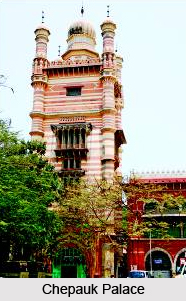 Chepauk Palace is one the popular palaces located in the vicinity of Chepauk in Chennai in the Indian state of Tamil Nadu. The palace served as the official residence of the Nawab of Arcot from 1768 to 1855.
Chepauk Palace is one the popular palaces located in the vicinity of Chepauk in Chennai in the Indian state of Tamil Nadu. The palace served as the official residence of the Nawab of Arcot from 1768 to 1855.
History of Chepauk Palace
The Nawab Muhammed Ali Khan Wallajah maintained a close relation with the Bristish. he even took help the British troops for his security and protection. At that time all the independent kingdom of the Carnatic has lost their independence during the end of the Carnatic Wars. They now became a protectorate of the British East India Company. In the year 1764 the Nawab thought of building a palace for himself inside the ramparts of Fort St George. Due to lack of space the plans had to be dropped out. He then constructed the palace at Chepauk. In the year 1855 when the principality of Carnatic was abolished according to the Doctrine of Lapse, the palace was sold off for paying the debts of the Nawab. It was then purchased by the Madras government. The palace was used as Public Works Department (PWD) Secretariat. A new records office was built in the year in 1871 by Robert Chisholm.
Architecture of Chepauk Palace
The Chepauk Palace has been built according to the Indo-Saracenic style of architecture. It has two blocks, the northern block and the southern Block. The northern block is known as Khalsa Mahal and the southern block is known as Humayun Mahal. The palace spreads over an area of 117 acres and has been enclosed by a wall.
This article is a stub. You can enrich by adding more information to it. Send your Write Up to content@indianetzone.com



















